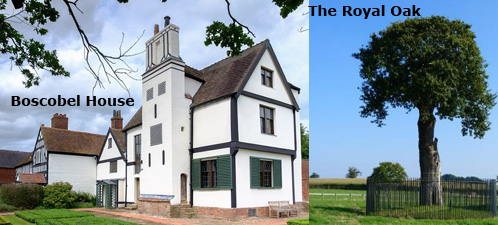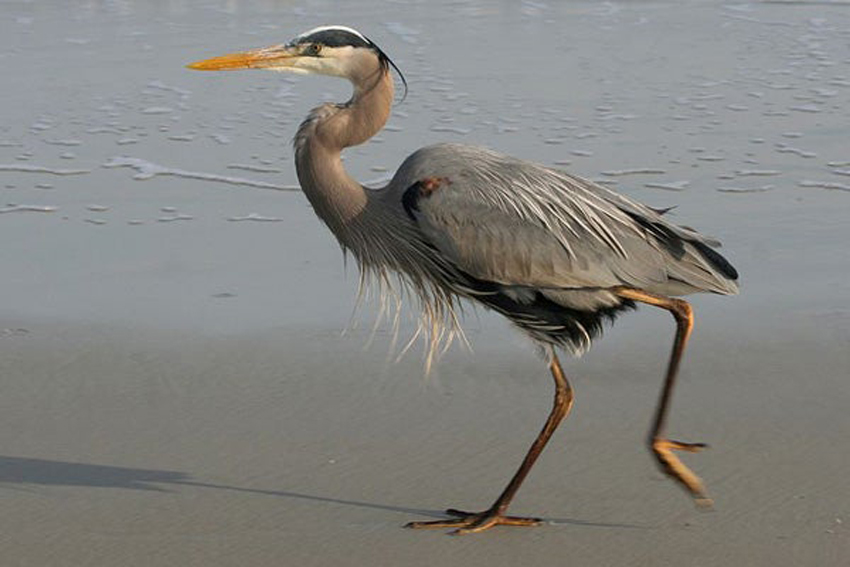




Back to the Shropshire Page

- The Royal Connection
- Shropshire Eats
- Owlbut's Birdwatch
- Shropshire VIPs
 Although King Charles I was executed in
January 1649, the Civil War continued on and off for a few years afterwards. The final battle took place at Worcester on 3 September 1651. The Royalist forces were
commanded by Charles' son, later to be Charles II of England. At the time he was still King of Scotland. The battle was a defeat for the Royalists and Charles was
forced the flee the battlefield.
Although King Charles I was executed in
January 1649, the Civil War continued on and off for a few years afterwards. The final battle took place at Worcester on 3 September 1651. The Royalist forces were
commanded by Charles' son, later to be Charles II of England. At the time he was still King of Scotland. The battle was a defeat for the Royalists and Charles was
forced the flee the battlefield.
Charles was then taken to Boscobel House in Shropshire. The owners were royalist supporters. When the Parliamentarian forces came looking for Charles
he hid in an Oak tree and avoided capture. The tree, or a descendant, is now known as the Royal Oak. A reward of £1,000 was put up for information about the whereabouts of Charles
and people were told that anyone hiding the King would be killed without mercy. When he came down from the tree, Charles spent the night in hiding in the house and
was then, eventually, taken in a coal boat from Shoreham in West Sussex to France, arriving there on 15 October 1651.
When Charles was restored to the throne, he arrived back in London on May 29th 1660, his 30th birthday. The government decided that May 29 should be a
public holiday. It became known as Oak Apple Day and people would wear a sprig of oak leaves or an oak apple on their clothing. The holiday was abolished in 1859
but the day is still celebrated in some places in England. The oak was chosen to symbolise the fact that Charles hid in an oak tree.
![]() Back to the top
Back to the top
The Shrewsbury cake or Shrewsbury biscuit
(definitely more biscuit-like to my trained eye) has been around for over 400 years and has evolved over the years.
The originals were more delicate and fragile than those that are made nowadays. The biscuits (or cakes) can be any size,
allowing you to nibble a few or feast on one large one.
The cakes are made from dough that contains sugar, flour, egg, butter, and lemon zest. The diamond patterns across the top, apparently made with a
comb, are thought to be there to make it easier, and more lady-like, to break the biscuit (it's not a cake, come on) in to smaller pieces.
![]() Back to the top
Back to the top
The Grey Heron is easy to spot with long legs, a long beak and grey, black and white feathers. They can be seen anywhere near
water. They eat lots of fish but also small birds like ducklings and also voles (not if I get there first although maybe I'll let them - they are a bit big).
In fact they can be up to 100cms long, have a wingspan of about 190cms and weigh between 1.5 and 2 kg. There are 13,000 breeding pairs in the UK but
during winter five times that number may be here. As I said they have grey, black and white feathers which can look a bit straggly. Their beaks are long and
powerful, mainly yellow. Their natural habitat is woodland, farmland, grassland and general wetlands, rivers, lakes and ponds.
Richard tells me he saw his first ever heron on his first trip around England near Watersmeet House in Devon. It was sitting high up in a tree, a
place where they also lay their eggs and make their nests, hopefully not in that order.

Seven random people who were born in Shropshire in the last 100 years:-
Joe Hart (Footballer), Barbara Pym (Novelist), Christine Hawley (Architect), Lizzy Clark (Actress and Campaigner), Ian Woosnam (Golfer - I thought he was
Welsh), Sandy Lyle (Golfer - I thought he was Scottish) and Hotchy (YouTube Star)
![]() Back to the top
Back to the top

